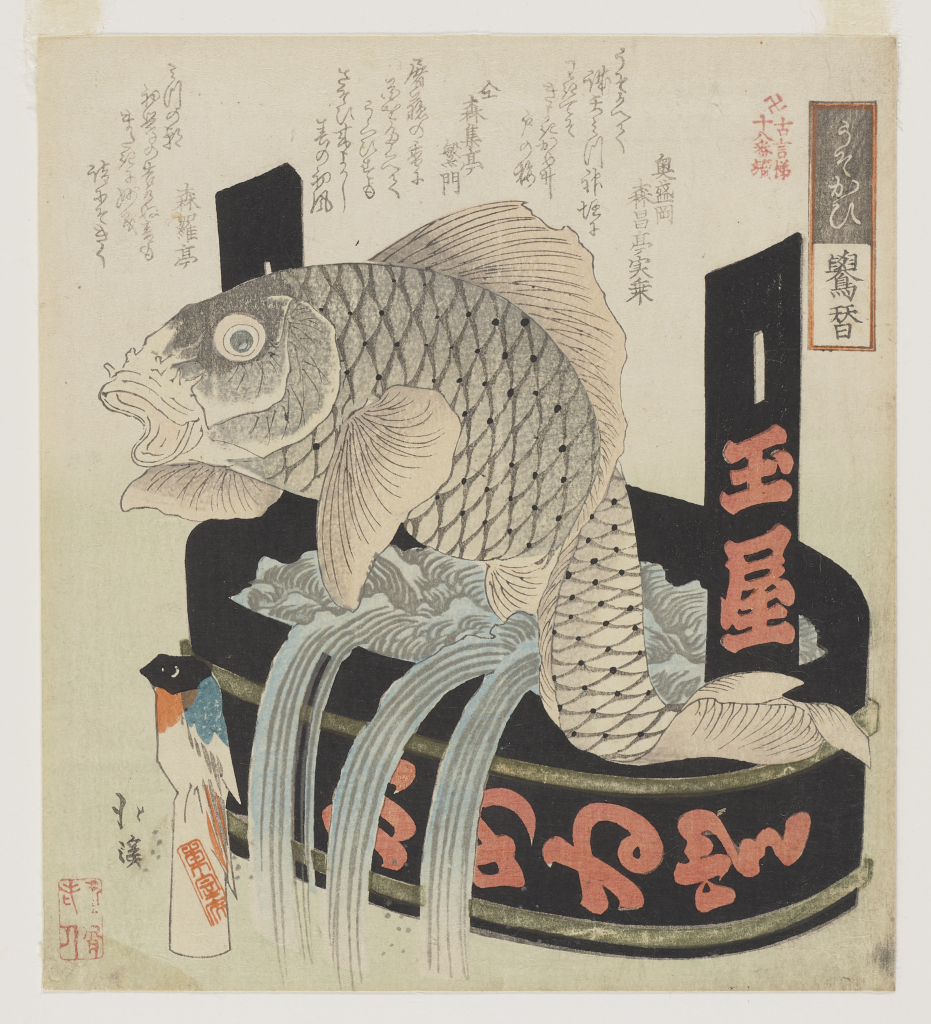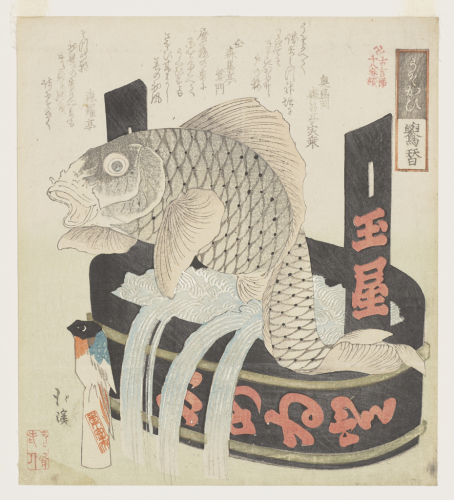Usokai (Bullfinch Exchange), from the series Kogentei jūhachiban tsuzuki (Eighteen illustrations for A Ladder to the Ancient Language)

Totoya Hokkei, Usokai (Bullfinch Exchange), from the series Kogentei jūhachiban tsuzuki (Eighteen illustrations for A Ladder to the Ancient Language), probably 1831, year of the rabbit, color woodblock print with metallic pigments on paper; shikishiban surimono, The Mary Andrews Ladd Collection, public domain, 32.673

This work is not currently on view.
- Title
Usokai (Bullfinch Exchange), from the series Kogentei jūhachiban tsuzuki (Eighteen illustrations for A Ladder to the Ancient Language)
- Related Titles
catalog entry: Usokai (Bullfinch Exchange): Carp leaping out of a lacquer bucket alongside a carved wooden bullfinch, from the series Kogentei jûhachiban tsuzuki (Eighteen illustrations for A Ladder to the Ancient Language)
original language: うそかひ 鷽替
series (original language): 古言隊十八番続
series (translated): Eighteen illustrations for A Ladder to the Ancient Language
series (transliterated): Kogentei jūhachiban tsuzuki
translated: Bullfinch Exchange
transliterated: Usokai
- Artist
- Date
probably 1831, year of the rabbit
- Period
Japan: Edo period (1615-1868)
- Medium
color woodblock print with metallic pigments on paper; shikishiban surimono
- Catalogue Raisonné
Graybill 2011, cat. 84
- Dimensions (H x W x D)
image: 7 7/8 in x 7 1/4 in; sheet: 8 in x 7 1/4 in
- Inscriptions & Markings
series title: 卍 / 古言隊 // 十八番続, printed in red ink, upper left Transliteration (Translation): Manji // Kogentei // jūhachiban tsuzuki ([symbol of the Manji poetry circle] Eighteen illustrations for a ladder to the ancient languages) Language: Japanese
title: うそかひ // 鷽替, printed in black intaglio and relief within rectangular cartouche with red border, upper right Transliteration (Translation): usokai // usokai (bullfinch exchange) Language: Japanese
inscription: , printed in black ink, upper left Transliteration (Translation): Shinratei // Mitsu no asa // hatsu uguisu no tsugenu ne mo // madaki ni Myōgi // mōde ni zo kiku (The song of the warbler on the “three mornings” of spring can be heard at the crack of dawn on the way to Myōgi Shrine [by] Shinratei) Language: Japanese Description: Poem by Shinratei. Translation from Graybill 2011.
inscription: , printed in black ink, upper middle Transliteration (Translation): Shinshūtei Shigekado // Toso no ka ni hana o // taguete // uguisu mo // sasoi koyokashi // haru no hatsukaze (Along with the fragrance of New Year’s spiced sake and that of blossoms, the spring’s first breeze summons the warbler’s song [by] Shinshūtei Shigekado) Language: Japanese Description: Poem by Shinshūtei Shigekado. Translation from Graybill 2011.
collector's mark: 玉屑武人, printed in red relief within rectangular cartouche, bottom left Transliteration (Translation): Gyokusetsu Bujin (Warrior of Poetry) Language: Japanese
signature: 北渓, printed in black ink, lower left Transliteration: Hokkei Language: Japanese
inscription: , printed in black ink, upper right Transliteration (Translation): Oka Morioka // Shinshōtei Minoti // Usokaete // makoto Amamitsu kamigaki ni // wakite zo // kiyoki Kameido no ume (Lies turn into truth in the sacred precincts of Amamitsu Shrine, where clear water wells up amid the plums of Kameido [by] Shinshōtei Minori, Morioka of Oku) Language: Japanese Description: Poem by Shinshōtei Minori. Translation from Graybill 2011.
- Collection Area
Asian Art; Graphic Arts
- Category
Prints
Japanese Traditional Prints
- Object Type
relief print
- Culture
Japanese
- Credit Line
The Mary Andrews Ladd Collection
- Accession Number
32.673
- Copyright
public domain
- Terms
- Exhibitions
2011 The Artist's Touch, The Craftsman's Hand: Three Centuries of Japanese Prints from the Portland Art Museum Portland Art Museum









